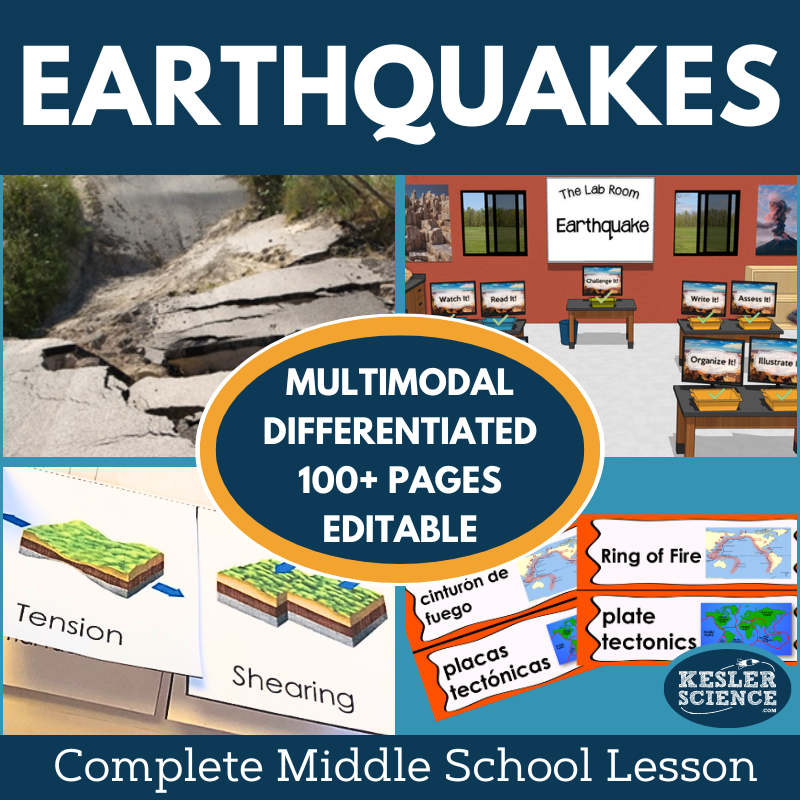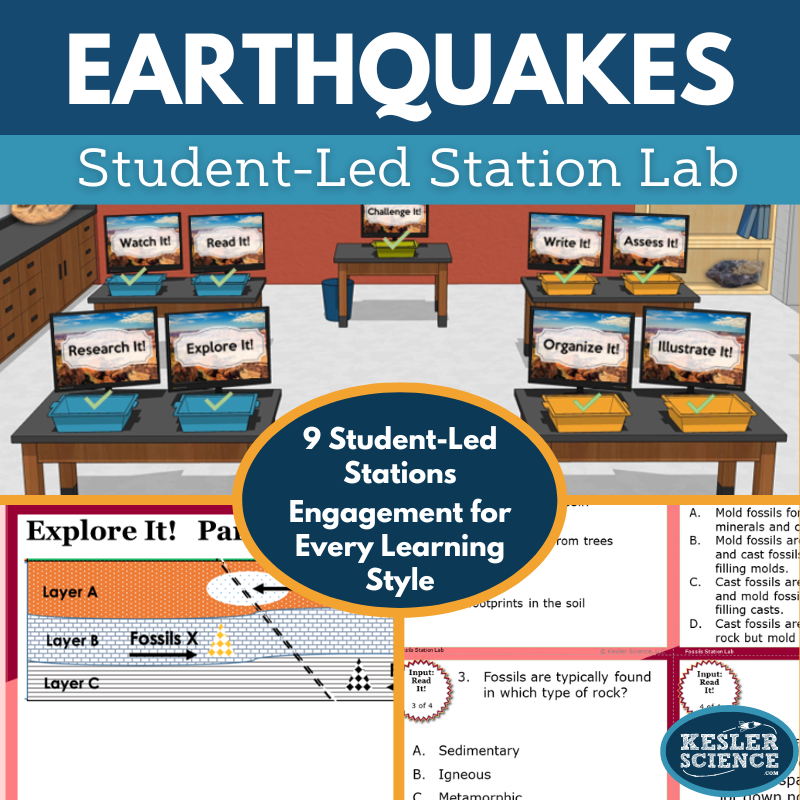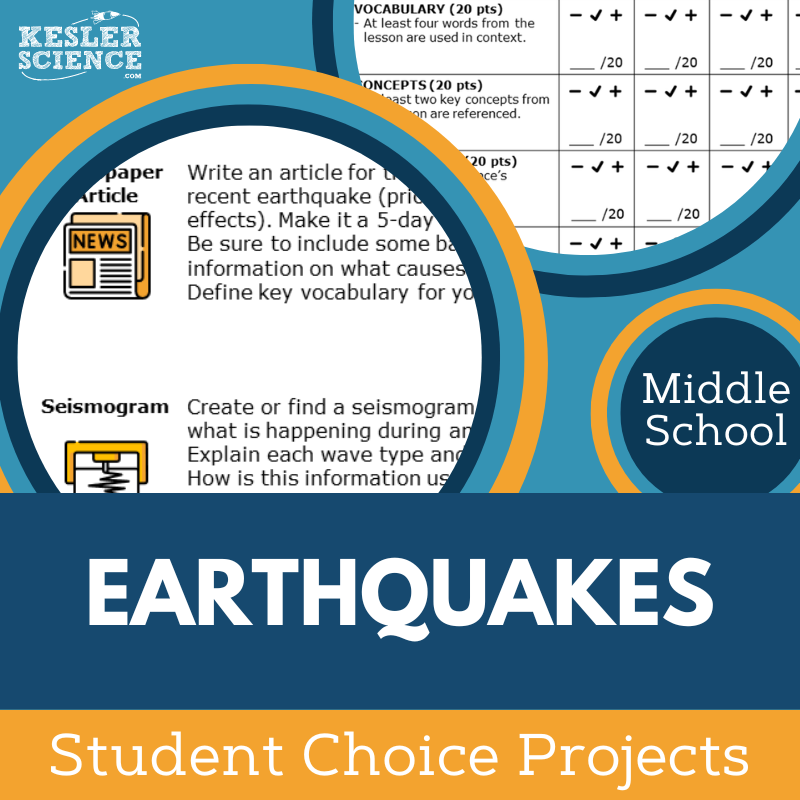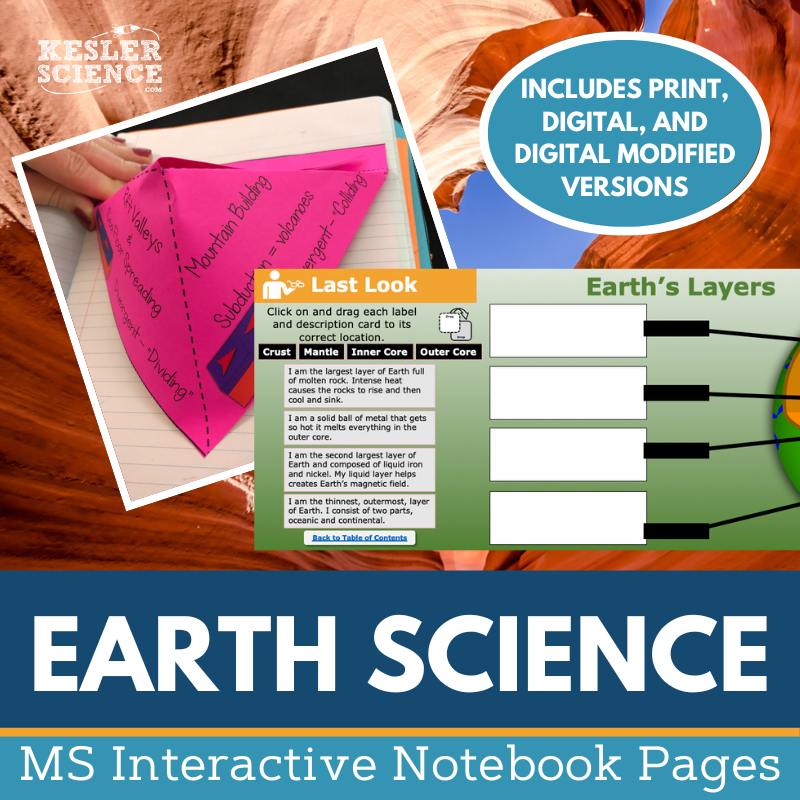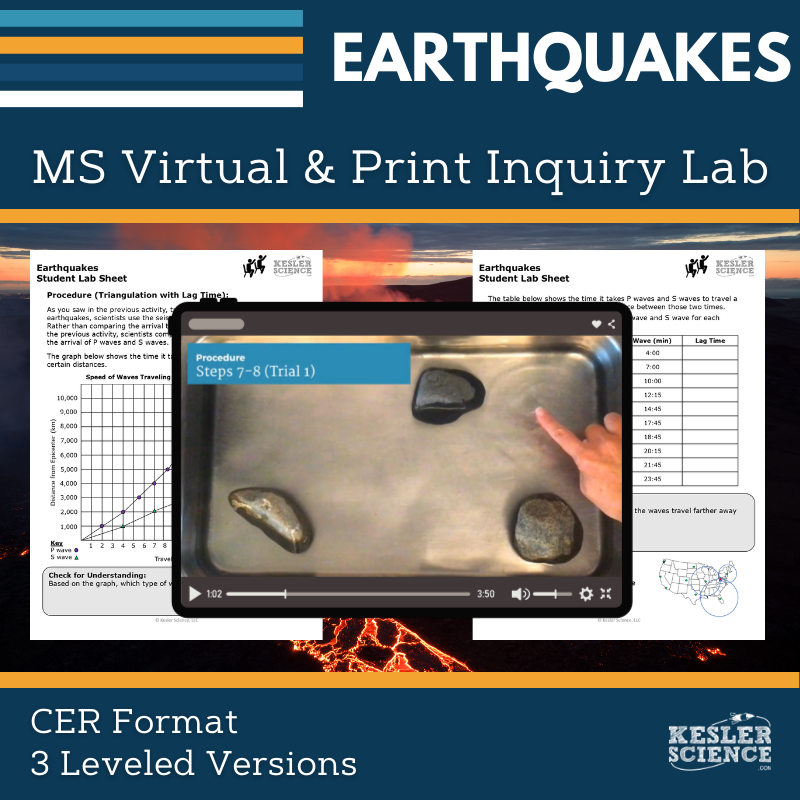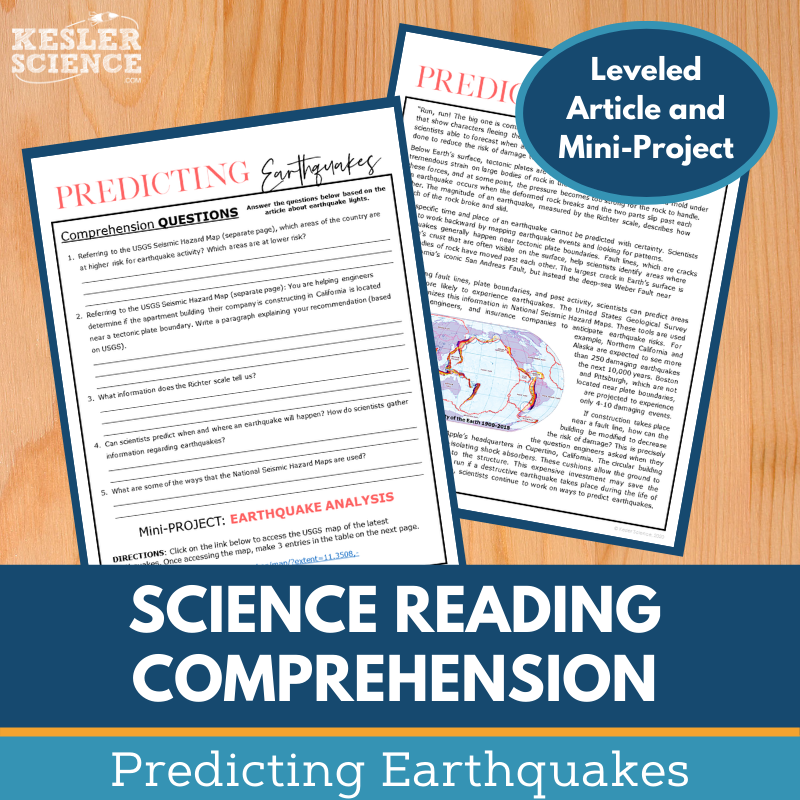Earthquakes Activities for Middle School Science
This comprehensive middle school earthquake unit follows the 5E Instructional Model. Students explore seismic waves, faults, epicenters, tsunamis, and earthquake preparedness through a multimodal, student-led station lab featuring hands-on tasks, videos, readings, and digital research. The resources below will give students a comprehensive understanding of earthquakes. All of the following materials are also included in the Kesler Science Membership.
This middle school earthquake unit is a complete, low-prep resource built around the 5E Instructional Model. It includes editable presentations, differentiated worksheets, assessments, student-choice projects, and interactive notebook pages in both English and Spanish. The lesson supports student-led learning with multimodal materials suitable for in-person or virtual settings and helps students explore key concepts such as seismic waves, faults, epicenters, tsunamis, and earthquake preparedness.
During the Exploration phase, students rotate through nine differentiated stations, including hands-on activities, readings, videos, and digital research. These input stations engage students through various learning styles, while output stations provide opportunities to organize, write, draw, and demonstrate understanding. A challenge station offers enrichment for early finishers. The Explanation phase features editable PowerPoints and note-taking tools, and the Elaboration phase includes creative student-choice projects.
The unit concludes with STAAR 2.0-aligned assessments in standard and modified versions, along with review worksheets and class discussion prompts. With its flexible format, built-in differentiation, and alignment to science standards, this lesson provides a structured, engaging approach to teaching earthquakes in a middle school classroom.
This middle school earthquake unit is a complete, low-prep resource built around the 5E Instructional Model. It includes editable presentations, differentiated worksheets, assessments, student-choice projects, and interactive notebook pages in both English and Spanish. The lesson supports student-led learning with multimodal materials suitable for in-person or virtual settings and helps students explore key concepts such as seismic waves, faults, epicenters, tsunamis, and earthquake preparedness.
During the Exploration phase, students rotate through nine differentiated stations, including hands-on activities, readings, videos, and digital research. These input stations engage students through various learning styles, while output stations provide opportunities to organize, write, draw, and demonstrate understanding. A Challenge Station offers enrichment for early finishers. The Explanation phase features editable PowerPoints and note-taking tools, and the Elaboration phase includes creative student-choice projects.
The unit concludes with STAAR 2.0-aligned assessments in standard and modified versions, along with review worksheets and class discussion prompts. With its flexible format, built-in differentiation, and alignment to science standards, this lesson provides a structured, engaging approach to teaching earthquakes in a middle school classroom.
The Kesler Science Earthquakes Station Lab provides an engaging, student-led activity for middle schoolers to explore the causes of earthquakes and the differences between an epicenter and a focus. With modular, differentiated activities, the lab allows students to direct their learning while saving teachers valuable prep time.
The station lab features nine activities, including hands-on demonstrations, research tasks, reading passages, videos, and creative output stations like drawing, writing, and organizing. Differentiated materials ensure accessibility for all learners, with Spanish and English options available for text-based activities. A bonus challenge station provides extension activities for advanced students or early finishers.
Designed for flexibility, the lab includes all necessary signage, task cards, and resources, with minimal additional materials required. This engaging, multimodal approach helps students build a comprehensive understanding of earthquakes while fostering creativity, retention, and independent learning.
The Kesler Science Earthquakes Station Lab provides an engaging, student-led activity for middle schoolers to explore the causes of earthquakes and the differences between an epicenter and a focus. With modular, differentiated activities, the lab allows students to direct their learning while saving teachers valuable prep time.
The station lab features nine activities, including hands-on demonstrations, research tasks, reading passages, videos, and creative output stations like drawing, writing, and organizing. Differentiated materials ensure accessibility for all learners, with Spanish and English options available for text-based activities. A bonus challenge station provides extension activities for advanced students or early finishers.
Designed for flexibility, the lab includes all necessary signage, task cards, and resources, with minimal additional materials required. This engaging, multimodal approach helps students build a comprehensive understanding of earthquakes while fostering creativity, retention, and independent learning.
The Kesler Science Earthquakes Student Choice Projects challenge middle schoolers to explore seismic concepts creatively. Students can select from six project options or design their own, tailoring their learning to their preferred style. The included grading rubric supports assessments by teachers, peers, or students themselves, offering flexibility to adapt to various classroom needs.
With multimodal and differentiated options, these projects cater to diverse learning needs. Modified versions support students requiring remediation, while advanced learners can tackle multiple projects for a deeper dive. Teachers can adjust the editable rubric to evaluate vocabulary, scientific concepts, presentation, and accuracy, ensuring alignment with academic goals.
Projects are designed to use readily available classroom supplies like paper, markers, and scissors, with digital completion options for tech-integrated classrooms. These engaging, flexible activities foster creativity and deeper understanding, making them an excellent addition to any earth science curriculum.
The Kesler Science Earthquakes Student Choice Projects challenge middle schoolers to explore seismic concepts creatively. Students can select from six project options or design their own, tailoring their learning to their preferred style. The included grading rubric supports assessments by teachers, peers, or students themselves, offering flexibility to adapt to various classroom needs.
With multimodal and differentiated options, these projects cater to diverse learning needs. Modified versions support students requiring remediation, while advanced learners can tackle multiple projects for a deeper dive. Teachers can adjust the editable rubric to evaluate vocabulary, scientific concepts, presentation, and accuracy, ensuring alignment with academic goals.
Projects are designed to use readily available classroom supplies like paper, markers, and scissors, with digital completion options for tech-integrated classrooms. These engaging, flexible activities foster creativity and deeper understanding, making them an excellent addition to any earth science curriculum.
The Kesler Science Earth Science Interactive Notebook Bundle is a must-have for teachers who want to provide an interactive learning experience in earth science. It includes both print and digital versions, making it a versatile resource for traditional classrooms, 1:1 environments, and distance learning.
The bundle covers a wide range of earth science topics, including Continental Drift Theory, plate boundaries, rocks and minerals, the rock cycle, Earth’s layers, volcanoes, earthquakes, and more. It also features activities like Venn diagrams, topographic maps, and reflection pages to help students demonstrate understanding and make connections between concepts.
The digital version includes a unique interactive notebook PowerPoint, which can be uploaded to Google Slides or learning management systems like MS Teams and Canvas. The paper version provides blank and pre-filled templates, along with color photos to guide students in completing each activity. Both versions come with a teacher answer key and a modified version for students with accommodations.
The Kesler Science Earth Science Interactive Notebook Bundle is a must-have for teachers who want to provide an interactive learning experience in earth science. It includes both print and digital versions, making it a versatile resource for traditional classrooms, 1:1 environments, and distance learning.
The bundle covers a wide range of earth science topics, including Continental Drift Theory, plate boundaries, rocks and minerals, the rock cycle, Earth’s layers, volcanoes, earthquakes, and more. It also features activities like Venn diagrams, topographic maps, and reflection pages to help students demonstrate understanding and make connections between concepts.
The digital version includes a unique interactive notebook PowerPoint, which can be uploaded to Google Slides or learning management systems like MS Teams and Canvas. The paper version provides blank and pre-filled templates, along with color photos to guide students in completing each activity. Both versions come with a teacher answer key and a modified version for students with accommodations.
The Earthquake Inquiry Lab aligns with NGSS standards and engages students in identifying the epicenter of an earthquake by calculating lag time. Students explore how seismic data is used to locate epicenters through either a hands-on printed lab or an interactive digital version, both including comprehension questions, C.E.R. prompts, and a reflection section.
Three differentiated versions—Dependent, Modified, and Independent—are included to meet the needs of all learners. The printed lab involves simple materials such as a pan, map, rocks, and a compass, while the digital format requires no physical supplies and includes built-in interactive elements for remote or absent students.
The resource is fully editable, compatible with Google Slides, and designed for maximum flexibility. Teacher support materials, answer keys, and clearly outlined objectives make it easy to implement. This lab offers a multimodal, student-centered experience that brings earth science concepts to life.
The Earthquake Inquiry Lab aligns with NGSS standards and engages students in identifying the epicenter of an earthquake by calculating lag time. Students explore how seismic data is used to locate epicenters through either a hands-on printed lab or an interactive digital version, both including comprehension questions, C.E.R. prompts, and a reflection section.
Three differentiated versions—Dependent, Modified, and Independent—are included to meet the needs of all learners. The printed lab involves simple materials such as a pan, map, rocks, and a compass, while the digital format requires no physical supplies and includes built-in interactive elements for remote or absent students.
The resource is fully editable, compatible with Google Slides, and designed for maximum flexibility. Teacher support materials, answer keys, and clearly outlined objectives make it easy to implement. This lab offers a multimodal, student-centered experience that brings earth science concepts to life.
In this dynamic lesson, students explore the science of earthquake prediction through a nonfiction article and a hands-on analysis of a USGS earthquake map. Designed to enhance science literacy and comprehension, the activity combines reading, critical thinking, and real-world application. Middle school students engage with leveled passages, comprehension questions, and an interactive mini-project.
The lesson includes two differentiated articles (Lexile levels 1100-1300), comprehension questions, a Cornell notes template, and a hands-on mini-project. Vibrant, printable graphics and editable files ensure flexibility for both in-person and virtual learning environments. Students can work directly within digital formats, such as Google Classroom or other LMS platforms, making it ideal for distance learning, sub plans, or extra credit.
This resource fosters science literacy while encouraging classroom discussion and independent learning. Whether used as part of a routine or to deepen understanding of earth science topics, the activity supports textual analysis, critical thinking, and engagement with real-world seismic data.
In this dynamic lesson, students explore the science of earthquake prediction through a nonfiction article and a hands-on analysis of a USGS earthquake map. Designed to enhance science literacy and comprehension, the activity combines reading, critical thinking, and real-world application. Middle school students engage with leveled passages, comprehension questions, and an interactive mini-project.
The lesson includes two differentiated articles (Lexile levels 1100-1300), comprehension questions, a Cornell notes template, and a hands-on mini-project. Vibrant, printable graphics and editable files ensure flexibility for both in-person and virtual learning environments. Students can work directly within digital formats, such as Google Classroom or other LMS platforms, making it ideal for distance learning, sub plans, or extra credit.
This resource fosters science literacy while encouraging classroom discussion and independent learning. Whether used as part of a routine or to deepen understanding of earth science topics, the activity supports textual analysis, critical thinking, and engagement with real-world seismic data.
Year-Round Resources
These year-round activities will increase your students' understanding of many middle school science topics. All of these activities are also included in the Kesler Science Membership.
Visual Data & Graphing
You're not alone if your students struggle with understanding graphs, charts, and tables. It's a skill that takes an enormous amount of practice. This resource will help students build a strong foundation in analyzing data and creating their own data visualizations.
Bell Ringers and Warm-Ups
These middle school science bell ringers are an excellent way to engage your students as soon as they walk into your classroom. This comprehensive FULL YEAR resource includes everything you need to start off each science class with an interesting warm-up activity.
Review Board Games
Each game board has been carefully designed to keep students engaged. There are 10 different action spaces on each board and dozens of question cards. All of the actions are related to science concepts and keep the students motivated throughout the game.
Each game is ready to play. Simply print out the board and the cards and let the students enjoy reviewing nine different units.
Essential Questions
Below are the essential questions associated with the lessons and activities included in this unit. This topic is only one of more than 100 middle school science topics included in the Kesler Science Membership.
-
How do plate boundaries impact earthquakes?
-
How are stresses in rocks related to faults?
-
What are the characteristics of different types of seismic waves?
-
How are epicenters determined?
-
How do tsunamis form?
-
How are earthquakes measured?
-
How can humans prepare for the impact of an earthquake?
Kesler Science Membership
Imagine never having to search for another middle school science lesson again. The membership gives you access to ALL of the Kesler Science products in one place (Yes, including everything above).
Say goodbye to long hours of lesson prep.

